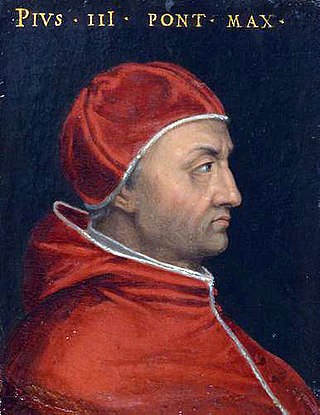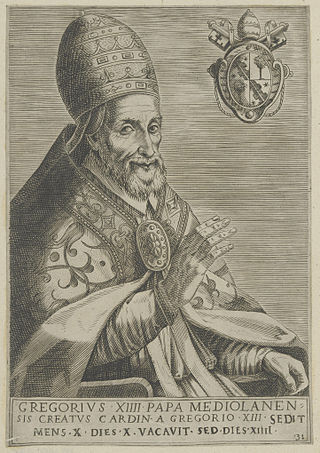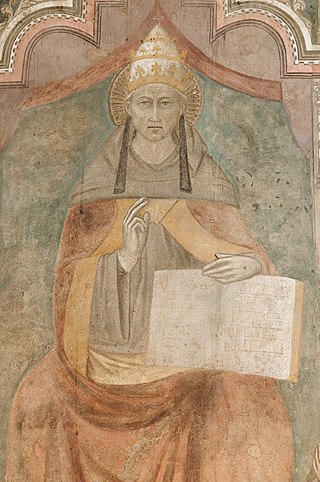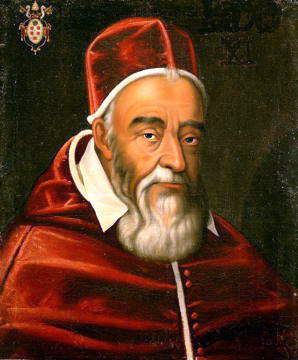
Pope Pius III, born Francesco Todeschini, was head of the Catholic Church and ruler of the Papal States from 22 September 1503 to his death. At just twenty-six days, he had one of the shortest pontificates in papal history.

Pope Gregory XIV, born Niccolò Sfondrato or Sfondrati, was head of the Catholic Church and ruler of the Papal States from 5 December 1590 to his death, in October 1591.

Pope Urban VII, born Giovanni Battista Castagna, was head of the Catholic Church, and ruler of the Papal States from 15 to 27 September 1590. His papacy was the shortest in history, during which a smoking ban encompassing churches across the world was implemented.

Pope Innocent X, born Giovanni Battista Pamphilj, was head of the Catholic Church and ruler of the Papal States from 15 September 1644 to his death, in January 1655.

Pope Leo XI, born Alessandro Ottaviano de' Medici, was head of the Catholic Church and ruler of the Papal States from 1 April 1605 to his death, on 27 April 1605. His pontificate is one of the briefest in history, having lasted under a month. He was from the prominent House of Medici originating from Florence. Medici's mother opposed his entering the priesthood and sought to prevent it by having him given secular honours, but after her death he eventually was ordained a priest in 1567. In his career he served as Florence's ambassador to the pope, Bishop of Pistoia, Archbishop of Florence, papal legate to France, and as the cardinal Prefect for the Congregation of the Bishops and Religious. He was elected to the papacy in the March 1605 papal conclave and served as pope for 27 days.

1590 (MDXC) was a common year starting on Monday of the Gregorian calendar and a common year starting on Thursday of the Julian calendar, the 1590th year of the Common Era (CE) and Anno Domini (AD) designations, the 590th year of the 2nd millennium, the 90th year of the 16th century, and the 1st year of the 1590s decade. As of the start of 1590, the Gregorian calendar was 10 days ahead of the Julian calendar, which remained in localized use until 1923.

Pope Sixtus V, born Felice Piergentile, was head of the Catholic Church and ruler of the Papal States from 24 April 1585 to his death, in August 1590. As a youth, he joined the Franciscan order, where he displayed talents as a scholar and preacher, and enjoyed the patronage of Pius V, who made him a cardinal. As a cardinal, he was known as Cardinal Montalto.

Pompeo Colonna was an Italian noble, condottiero, politician, and cardinal. At the culmination of his career he was Viceroy of the Kingdom of Naples (1530–1532) for the Emperor Charles V. Born in Rome, he was the son of Girolamo Colonna, whose father Antonio was second Prince of Salerno; and Vittoria Conti, of the Conti de Poli. His family belonged to the highest rank of nobility both of the City of Rome and of the Kingdom of Naples. Pompeo and his family were hereditary supporters of the Holy Roman Empire (Ghibbelines), and they spent their careers fighting their hereditary enemies, the Orsini family, and defending and expanding their family territories and interests. He played a significant, if sometimes disruptive, role in the Conclaves of 1521 and 1523 on behalf of the Imperial interest. His family commitments and his conclave activities brought Pompeo into conflict with the second Medici pope, Clement VII, whose election he vigorously opposed, and made him a leading figure in the attempted overthrow of Pope Clement and the Sack of Rome in 1527.

A cardinal-nephew was a cardinal elevated by a pope who was that cardinal's relative. The practice of creating cardinal-nephews originated in the Middle Ages, and reached its apex during the 16th and 17th centuries. The last cardinal-nephew was named in 1689 and the practice was abolished in 1692. The word nepotism originally referred specifically to this practice, when it appeared in the English language about 1669. From the middle of the Avignon Papacy (1309–1377) until Pope Innocent XII's anti-nepotism bull, Romanum decet pontificem (1692), a pope without a cardinal-nephew was the exception to the rule. Every Renaissance pope who created cardinals appointed a relative to the College of Cardinals, and the nephew was the most common choice, although one of Alexander VI's creations was his own son.

The 1292–94 papal election, was the last papal election which did not take the form of a papal conclave. After the death of Pope Nicholas IV on 4 April 1292, the eleven surviving cardinals deliberated for more than two years before electing the third of six non-cardinals to be elected pope during the Late Middle Ages: Pietro da Morrone, who took the name Pope Celestine V.

The 1592 papal conclave elected Pope Clement VIII in succession to Pope Innocent IX.

The 1769 papal conclave, was convoked after the death of Pope Clement XIII. It elected as his successor Cardinal Lorenzo Ganganelli, who took the name Clement XIV.

The 1585 papal conclave, convoked after the death of Pope Gregory XIII, elected Cardinal Felice Peretti Montalto (O.F.M.Conv), who took the name Sixtus V. Forty-two of the sixty cardinals participated in the conclave. The absence of thirty percent of the cardinalate makes this conclave one of the most sparsely attended in the history of the modern Roman Catholic Church. Fourteen of Gregory XIII's thirty cardinals failed to attend, a startlingly high number.

The 1724 papal conclave was called upon the death of Pope Innocent XIII. It began on 20 March 1724 and ended on 28 May that year with the election of Cardinal Vincenzo Maria Orsini, a Dominican friar, as Pope Benedict XIII. The conclave was made of largely the same electors that had elected Innocent in 1721 and the same factions dominated it. Multiple attempts were made to elect candidates that would be acceptable to the various Catholic monarchies at the time, but none were successful until May. Benedict resisted his own election for two days before being convinced to accept it.

The October to December 1590 papal conclave was the second conclave of 1590, and the one during which Gregory XIV was elected as the successor of Urban VII. This conclave was marked by unprecedented royal interference from Philip II of Spain.

The March–April 1605 papal conclave was convened on the death of Pope Clement VIII and ended with the election of Cardinal Alessandro Ottaviano de' Medici as Pope Leo XI. It was the first of two papal conclaves in 1605; Leo died on 27 April 1605, twenty-six days after he was elected. The conclave was dominated by conflict over whether Cesare Baronius should be elected pope, and Philip III of Spain excluded both Baronius and the eventually successful candidate, Medici.

In the papal conclave held from 8 to 16 May 1605 Cardinal Camillo Borghes was elected to succeed Leo XI as pope. Borghes took the name Paul V. This was the second conclave of 1605, with the one that had elected Leo XI having concluded just 37 days earlier. It is significant for having the only recorded case of an injury at a papal conclave, which was the result of a physical fight amongst the cardinals over who should be elected pope.

Marco Antonio Colonna (1523–1597) was an Italian Roman Catholic bishop and cardinal.

Francesco Sforza (1562–1624) was an Italian cardinal and bishop. He was very influential in a number of conclaves.

The papal conclave of March–April 1605 was convened on the death of Pope Clement VIII and ended with the election of Alessandro Ottaviano de' Medici as Pope Leo XI on 1 April 1605. It was the first of two papal conclaves in 1605, with Leo dying on 27 April 1605, twenty-six days after he was elected, and the conclave to elect his successor being held in May. The conclave saw conflict regarding whether Cesare Baronius should be elected pope, and Philip III of Spain, the Spanish king, excluded both Baronius and the eventually successful candidate, Medici. Philip's exclusion of Medici was announced by Cardinal Ávila after his election to the papacy, and the other cardinals did not view it as valid since Medici had already been elected pope.



















